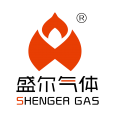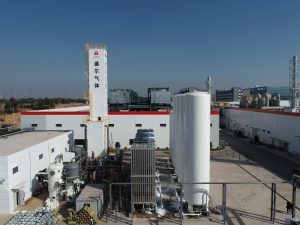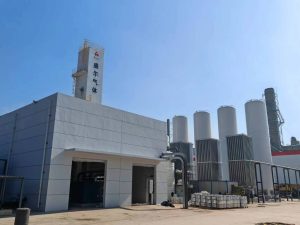How a Cryogenic Oxygen Plant works is straightforward: compressed, purified air is liquefied and split by boiling point in HP/LP columns.The cryogenic oxygen plant is a large-scale air separation unit that produces high-purity oxygen from ambient air by low-temperature fractional distillation. Ambient air is drawn in, compressed, and purified, then cooled until it liquefies. In the cryogenic distillation columns the liquid air separates by boiling point: nitrogen (b.p. –196 °C) exits as vapor, oxygen (b.p. –183 °C) is collected as liquid, and argon (b.p. –186 °C) can be extracted in a side column if required. The result is nearly pure streams of oxygen and nitrogen (and argon if recovered).
Process Overview
The core of a cryogenic oxygen plant is the air separation train. First, air compression brings in ambient air and raises it to moderate pressure (typically ~0.6–0.8 MPa, or about 6–8 bar). The compressed air is then pre-cooled (near 5–10 °C) to remove bulk moisture, and purified by molecular sieves that scrub residual water and CO₂ (dewpoint typically ≤–60 °C) to prevent icing. The cleaned air is next chilled in a counter-flow heat exchanger (cold box) that uses returning cryogenic streams. Part of the air may be expanded through a turboexpander or Joule–Thomson valve to generate additional refrigeration and bring the feed to –170 to –190 °C before entering the distillation columns.
Once sufficiently cold, the air enters the distillation columns. A typical setup uses a high-pressure (HP) column followed by a low-pressure (LP) column. The HP column produces nitrogen-rich vapor at the top and oxygen-rich liquid at the bottom. The oxygen-rich liquid is fed to the LP column, where nearly pure liquid oxygen collects at the bottom and high-purity nitrogen vapor leaves from the top. An intermediate side draw from the LP column contains an argon-rich fraction (roughly 7–15% argon) that can be sent to an argon purification column if argon recovery is desired.
After distillation, the product streams are brought to final conditions. The oxygen product may be pumped (if in liquid form) or compressed (if gas) to the required delivery pressure, and then warmed to ambient temperature if needed. The nitrogen product (often ≥99% purity) is typically warmed and vented or stored. Cryogenic oxygen plants are designed for continuous operation, often achieving ≥90–99% uptime to ensure a steady supply of oxygen and nitrogen.
Process steps:
- Air intake and compression: Ambient air → ~0.6–0.8 MPa (6–8 bar) via multi-stage compressors.
- Air cooling and purification: Pre-cool to ~5–10 °C; remove moisture/CO₂ in molecular sieves.
- Cryogenic heat exchange: Cool air to –170 to –190 °C by counter-current exchangers and expansion.
- Distillation: In cascade columns, nitrogen (b.p. –196 °C) boils off upward, oxygen (b.p. –183 °C) descends as liquid.
- Argon recovery (optional): Draw side-stream for argon purification (yields ~5–6% Ar by mass of O₂).
- Product recovery: Collect liquid O₂ (bottom of LP column) and vaporize or pump to supply pressure; take N₂ gas from column top.
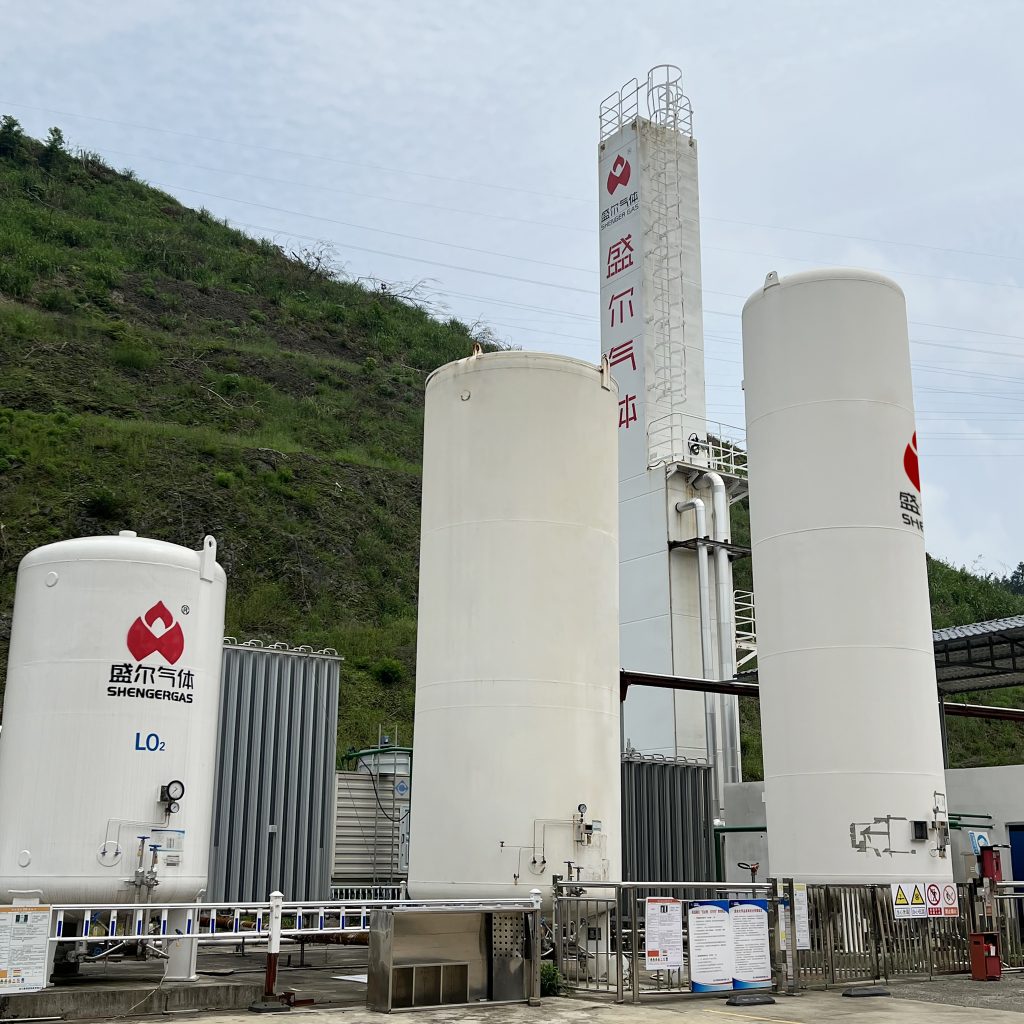
Cryogenic Oxygen Plant Specifications
Cryogenic oxygen plants are specified by capacity, purity, and pressure. Production capacity is usually given in normal cubic meters of O₂ per hour (Nm³/h) or in tonnes per day (t/d). Single-train ASUs often range from a few hundred to several thousand Nm³/h of O₂ output. Oxygen purity is adjustable by design: typical industrial installations provide ~95–99.6% O₂minnuogas.commathesongas.com, and higher purities (99.9%+) can be achieved for specialty needs. Product pressure depends on end use: for gas supply it is often a few bar (0.2–2.0 MPa), whereas liquid oxygen (LOX) can be pressurized to 10–20 MPa if needed for high-pressure pipelines or cylinder filling.
Below is a representative specification table for a mid-size cryogenic oxygen plant train:
| Parameter | Typical Value |
|---|---|
| Oxygen production | 100–5000 Nm³/h (per train) |
| Oxygen purity | ~95–99.6% (industrial/medical grade) |
| Product pressure | ~0.2–2.0 MPa (2–20 bar) gas O₂ |
| Energy consumption | ~0.4–0.7 kWh per Nm³ O₂ |
| Argon yield | ~0.05–0.06 kg Ar per kg O₂ (5–6% by mass) |
| Operating temperature | ~–183 °C (liquid O₂ boiling point) |
For example, a plant producing 1,000 Nm³/h of 99.5% O₂ might consume on the order of 0.5 kWh per Nm³ (about 450 kWh per tonne)pdfs.semanticscholar.orgshengerhk.com. Exact values depend on design choices like final pressure, ambient conditions, and cold-box size. Larger heat exchange area and additional subcooling stages can approach the lower end of these energy figures.
Cryogenic Oxygen Plant Energy Use
For project scoping, a Cryogenic Oxygen Plant is typically chosen once demand exceeds ~200–300 t/d O₂ because scale reduces kWh per tonne.Cryogenic air separation is inherently energy-intensive. The theoretical minimum work to separate oxygen from air is only ~51 kWh per tonne of O₂, but real plants require several times thatshengerhk.com. Modern cryogenic ASUs typically use roughly 300–600 kWh per tonne of O₂ (about 0.4–0.7 kWh per Nm³)shengerhk.com. Energy use increases with higher product pressure or higher purity. For instance, delivering oxygen at 40 bar might consume ~500 kWh/t, whereas delivering at 7 bar might be closer to 400 kWh/tshengerhk.com. The choice of refrigeration cycle (expander vs. mechanical) and integration with downstream cooling also affect efficiency.
Key factors affecting energy use:
- Delivery pressure: Compressing or pumping oxygen to high pressures (for LOX or high-pressure pipelines) requires more power.
- Product purity: Stricter O₂ purity (e.g. >99.5%) demands extra reflux and refrigeration, raising energy consumption.
- Equipment design: Larger cold-box heat exchangers and multi-stage expanders can improve thermodynamic efficiency (at higher CAPEX).
Electricity for compressors and refrigeration typically dominates operating costs (often ~70–80% of OPEX)shengerhk.com. At industrial rates (e.g. $0.05–$0.10 per kWh), power can add on the order of $20–$50 per tonne of O₂shengerhk.com. Optimizing the ASU (balancing CAPEX vs. OPEX) is crucial: more investment in exchanger area and refrigeration yields lower energy use and vice versa.
Operating Conditions
Cryogenic oxygen plants run under carefully controlled conditions. Feed air must be clean (oil-free) and dried to avoid icing. Molecular sieves typically reduce water/CO₂ to a dewpoint of –60 °C or lower. The compressor train is multi-stage with intercoolers, designed for the chosen pressure (commonly around 6–8 bar output). The cold box handles the –185 °C regime: it uses aluminum plate-fin exchangers and low-temperature piping, with oxygen-friendly materials (stainless steel or aluminum) throughout to prevent ignition hazards. Safety systems include oxygen monitors and inert purges to prevent oxygen accumulation in air-side equipment.
The ASU generally operates continuously at design load. Large cryogenic plants often report annual uptimes above 99%mathesongas.com, with only brief shutdowns for scheduled maintenance (e.g. molecular sieve changes or minor column cleanups). Control systems maintain column pressures near ambient and regulate reflux flows to achieve the set O₂/N₂ split. Start-up and shutdown procedures ensure that O₂-rich streams are not introduced to parts of the plant not designed for them.
Ambient factors (e.g. elevation, temperature) are accounted for in design. Higher ambient temperature or altitude reduces air density, increasing compressor power for a given O₂ output. Cooling resources (water or air-cooled heat exchangers) must remove the compression heat. Typically a plant is rated at a standard condition (e.g. 25 °C, sea level); performance curves show output variation with ambient changes. Overall, cryogenic ASUs are robust, but they need proper ventilation and oxygen monitoring on-site due to the large potential flows of oxygen and nitrogen.

Sizing Considerations
Sizing a cryogenic oxygen plant involves matching capacity, flexibility, and reliability to the application. Key considerations include:
- Demand capacity: Estimate peak and average O₂ usage (often in t/d or Nm³/h). Size the plant for maximum demand plus margin.
- Purity and products: Specify required O₂ purity. Decide if nitrogen and/or argon products are needed for sale or process use. Recovering argon can improve project economics if the market exists.
- Load profile: Continuous high-load applications typically use one or more large ASU trains. For variable or intermittent demand, multiple smaller trains or hybrid solutions (PSA + cryogenic) may be used. Cryogenic ASUs usually allow good turndown (often down to ~50% of nominal).
- Redundancy: Critical users often install redundant trains (e.g. N+1 configuration) so one ASU can cover demand if another is offline. Redundancy may also involve stored liquid oxygen to ride through outages.
- Utilities and layout: Ensure adequate power supply (large ASUs may require tens of MW) and cooling (water or air). Provide space for the cold box (which can be several meters tall) and for cryogenic storage tanks. Also plan for oxygen piping or loading docks.
- Integration: Consider linking the ASU to processes that use waste heat or require oxygen pressure. For example, an oxygen-consuming furnace on-site can reduce compression needs if oxygen is delivered slightly pressurized.
Generally, larger cryogenic plants achieve better economics. Engineering guides suggest that above ~200–300 t/d O₂, cryogenic separation is typically more cost-effective than PSA/membrane methodsmathesongas.com. Very large plants (hundreds to thousands of t/d) benefit from economies of scale and more efficient refrigeration. For very small demands (tens of t/d or less), non-cryogenic systems (PSA/VPSA) may be considered instead, as they have lower CAPEX and can be simpler, albeit with lower purity and higher energy use per tonne.
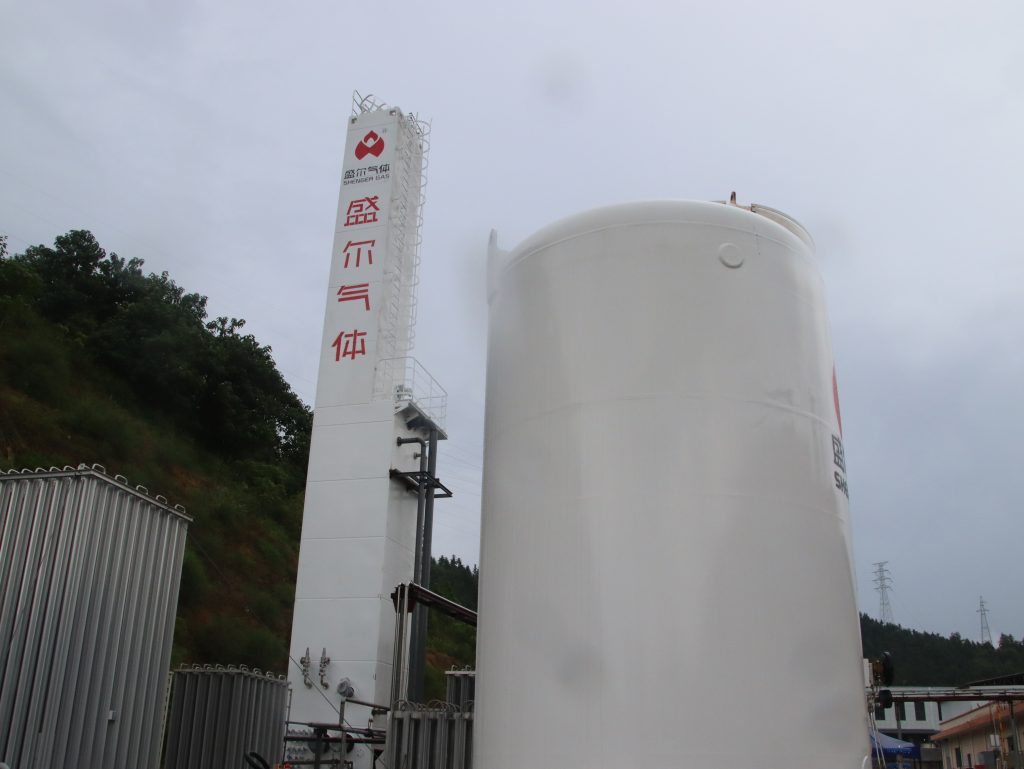
Cryogenic Oxygen Plant Cost Factors
Several economic factors govern the cost of a cryogenic oxygen plant:
- CAPEX drivers: Major capital costs are the air compressor (often ~50–80% of equipment cost), the aluminum cold-box heat exchangers, and the distillation columns. Installation costs (piping, foundations, instrumentation) and high-pressure oxygen storage also add to CAPEX. For context, industry estimates put ASU capital at roughly US$200–$300 per annual tonne of O₂ capacityshengerhk.com. For example, a multi-train project producing 9000 t/d O₂ (~3.3 Mt/year) had an implied cost of about $260 per annual tonne of capacity. CAPEX per unit output falls with scale: one survey found about $25 M for a 200 t/d plant versus $125 M for a 3000 t/d plantshengerhk.com, showing economies of scale (cost ∝ capacity^0.6–0.7).
- OPEX components: Electricity is the dominant operating cost (around 70–80% of OPEX)shengerhk.com. Other expenses include labor, maintenance (compressor rebuilds, column packing replacement), and minor consumables (lubricants, adsorbents), typically totaling 10–20% of OPEX. Power cost per tonne depends on local rates; for example, at $0.06/kWh and 500 kWh/t usage, electricity cost is about $30/t O₂shengerhk.com. Many operators negotiate special power contracts or shift loads to low-rate periods to reduce this expense.
- Argon credit: Cryogenic ASUs can recover argon (~1% of air by volume), which provides revenue offset. A typical argon yield is ~5–6 kg Ar per 100 kg O₂ producedshengerhk.com (about 0.05–0.06 kg Ar per kg O₂). At a representative price of $500–$600 per tonne Ar, this corresponds to roughly $25–$35 offset per tonne of O₂shengerhk.com. In practice, many economic models conservatively assume an “argon credit” of $10–$20 per tonne O₂ (after crediting the value of recovered argon). (If argon is not recovered, the buyer of the oxygen may demand a lower O₂ price in exchange.)
Balancing these factors is key in plant design. Larger plants spread fixed costs and can justify more efficient (but expensive) equipment to cut energy use, while small plants pay higher per-unit costs. Throughput, purity, and integration (e.g. sharing refrigeration with other processes) are engineered to meet the application’s requirements. The end result is a cryogenic oxygen plant that reliably delivers bulk oxygen at the specified purity and pressure, with predictable power consumption and cost structure.
